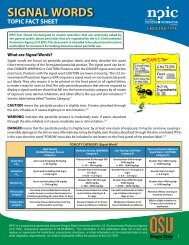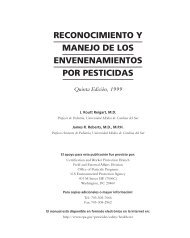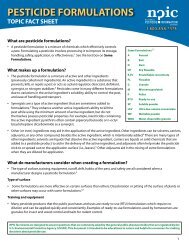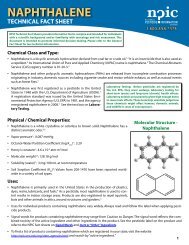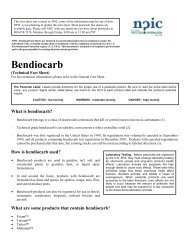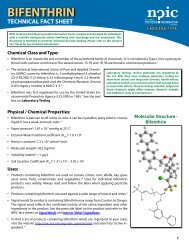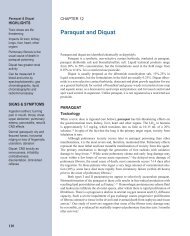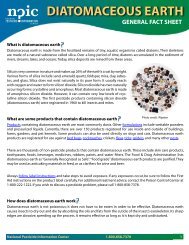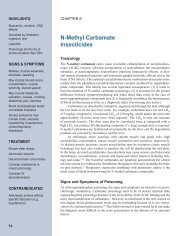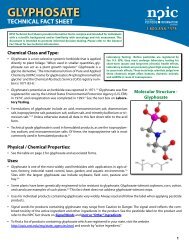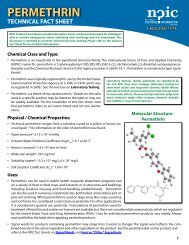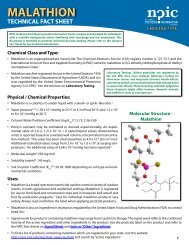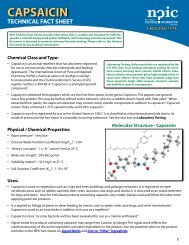Biologicals and Insecticides of Biological Origin - National Pesticide ...
Biologicals and Insecticides of Biological Origin - National Pesticide ...
Biologicals and Insecticides of Biological Origin - National Pesticide ...
Create successful ePaper yourself
Turn your PDF publications into a flip-book with our unique Google optimized e-Paper software.
CHAPTER 7<br />
Organochlorines<br />
The U.S. Environmental Protection Agency has sharply curtailed the availability <strong>of</strong><br />
most organochlorines. While use continues in many other regions <strong>of</strong> the world, in the<br />
United States only dic<strong>of</strong>ol <strong>and</strong> endosulfan are still registered as pesticides. Lindane is<br />
still marketed as a second-line agent for treatment <strong>of</strong> lice <strong>and</strong> scabies under the trade<br />
names Kwell <strong>and</strong> Thionex, although it is no longer recommended by the American<br />
Academy <strong>of</strong> Pediatrics <strong>and</strong> has been banned in California. This is the result <strong>of</strong> multiple<br />
cases <strong>of</strong> acute neurological toxicity either from ingestion or in persons treated for<br />
scabies or lice. 1,2,3,4,5,6,7 In recent years, the most frequently reported serious or fatal<br />
events were from endosulfan. 8,9,10,11,12,13,14<br />
Toxicology<br />
Organochlorines are absorbed from the gut, by the lungs <strong>and</strong> across the skin in<br />
varying degrees. Hexachlorocyclohexane, lindane, the cyclodienes (aldrin, dieldrin,<br />
endrin, chlordane, heptachlor) <strong>and</strong> endosulfan are efciently absorbed across<br />
the skin, while dermal absorption efciencies <strong>of</strong> DDT, dic<strong>of</strong>ol, methoxychlor, toxaphene<br />
<strong>and</strong> mirex are substantially less. 15 Lindane has an estimated 9.3% dermal<br />
absorption rate 16 <strong>and</strong> is absorbed even more efciently across abraded skin. 4,17 This<br />
becomes especially important when taking into account its use on children with severe<br />
dermatitis associated with scabies. Fat <strong>and</strong> fat solvents enhance gastrointestinal, <strong>and</strong><br />
probably dermal, absorption <strong>of</strong> organochlorines. Many formulations <strong>of</strong> organochlorines<br />
are in hydrocarbon solvents that probably promote absorption. While most <strong>of</strong> the<br />
solid organochlorines are not highly volatile, pesticide-laden aerosols or dust particles<br />
trapped in respiratory mucous <strong>and</strong> subsequently swallowed may be vehicles leading to<br />
signicant gastrointestinal absorption.<br />
Following exposure to some organochlorines notably T, a signicant part<br />
<strong>of</strong> the absorbed dose is stored in fat tissue as the parent compound. Most organochlorines<br />
are in some degree dechlorinated, oxidized <strong>and</strong> then conjugated. The chief route<br />
<strong>of</strong> excretion is biliary, although nearly all organochlorines yield measurable urinary<br />
metabolites. Unfortunately, many <strong>of</strong> the unmetabolized pesticides are efciently reabsorbed<br />
by the intestine (enterohepatic circulation), substantially retarding fecal excretion.<br />
Metabolic dispositions <strong>of</strong> DDT <strong>and</strong> DDE (a DDT degradation product), the beta<br />
isomer <strong>of</strong> hexachlorocyclohexane, dieldrin, heptachlor epoxide <strong>and</strong> mirex tend to be<br />
slow, leading to storage in body fat. Storable lipophilic compounds are likely to be<br />
excreted in maternal milk. 6,18,19 In contrast, rapid metabolic disposition <strong>of</strong> lindane,<br />
methoxychlor, dienochlor, endrin, chlorobenzilate, dic<strong>of</strong>ol, toxaphene, perthane <strong>and</strong><br />
endosulfan reduce the likelihood that these organochlorines will be detected as residues<br />
in body fat, blood or milk.<br />
The chief acute toxic action <strong>of</strong> the organochlorine pesticides is on the central<br />
nervous system, where these compounds induce a hyperexcitable state in the brain<br />
leading to convulsions or other less severe signs <strong>of</strong> neurologic toxicity such as<br />
myoclonic jerking, paresthesias, tremor, ataxia <strong>and</strong> hyperreexia. 20 Convulsions<br />
caused by cyclodienes may recur over periods <strong>of</strong> several days <strong>and</strong> are also characteristic<br />
<strong>of</strong> acute organochlorine poisoning. Agents such as DDT <strong>and</strong> methoxychlor tend<br />
HIGHLIGHTS<br />
Only dic<strong>of</strong>ol, endosulfan,<br />
lindane still registered for<br />
use in U.S.<br />
Absorbed from the gut, by<br />
the lungs <strong>and</strong> across skin<br />
Fat <strong>and</strong> fat solvents<br />
enhance absorption<br />
Most are dechlorinated,<br />
oxidized, then conjugated<br />
Chief toxic action is on CNS<br />
SIGNS & SYMPTOMS<br />
Sensory disturbances:<br />
hyperesthesia &<br />
paresthesias <strong>of</strong> face &<br />
extremities<br />
Possible headache,<br />
dizziness, nausea, vomiting,<br />
tremor, confusion<br />
Cyclodienes & toxaphene<br />
poisoning may result<br />
in seizures (including<br />
delayed ones) without other<br />
symptoms<br />
Severe poisonings:<br />
convulsions, respiratory<br />
depression, coma<br />
TREATMENT<br />
Manage convulsions<br />
Administer oxygen<br />
Decontaminate skin<br />
Consider GI<br />
decontamination<br />
Monitor cardiac, pulmonary<br />
status<br />
CONTRAINDICATED<br />
Epinephrine, other<br />
adrenergic amines, atropine<br />
in most cases<br />
Animal or vegetable oils by<br />
mouth<br />
63
CHAPTER 7<br />
Organochlorines<br />
COMMERCIAL<br />
PRODUCTS<br />
aldrin*<br />
BHC* (HCH, hexachlor,<br />
hexachloran)<br />
chlordane* (multiple trade<br />
names)<br />
chlorobenzilate*<br />
DDT* (multiple trade names)<br />
dic<strong>of</strong>ol (multiple trade<br />
names)<br />
dieldrin*<br />
dienochlor (Pentac)*<br />
endosulfan (Thionex)<br />
endrin*<br />
heptachlor*<br />
hexacholorobenzene*<br />
lindane (gamma BHC or<br />
HCH)*<br />
methoxychlor (Marlate)*<br />
mirex*<br />
toxaphene*<br />
to cause the less severe effects, while the cyclodienes, mirex <strong>and</strong> lindane are associated<br />
with the more severe seizures <strong>and</strong> fatalities. 15 Convulsions may cause death by<br />
interfering with pulmonary gas exchange <strong>and</strong> by generating severe metabolic acidosis.<br />
High tissue concentrations <strong>of</strong> organochlorines increase myocardial irritability,<br />
predisposing to cardiac arrhythmia. When tissue organochlorine concentrations drop<br />
below threshold levels, recovery from the poisoning occurs. Organochlorines are not<br />
cholinesterase inhibitors.<br />
High tissue levels <strong>of</strong> some organochlorines (notably DDT, DDE <strong>and</strong> cyclodienes)<br />
have been shown to induce hepatic microsomal drug-metabolizing enzymes. 21<br />
This tends to accelerate excretion <strong>of</strong> the pesticides themselves but may also stimulate<br />
biotransformation <strong>of</strong> endogenous steroid hormones <strong>and</strong> exogenous therapeutic drugs,<br />
occasionally necessitating reevaluation <strong>of</strong> required dosages <strong>of</strong> therapeutic drugs in<br />
persons intensively exposed to organochlorines. Human absorption <strong>of</strong> organochlorine<br />
sufcient to cause enzyme induction is likely to occur only as a result <strong>of</strong> prolonged,<br />
intensive exposure.<br />
Ingestion <strong>of</strong> hexachlorobenzene-treated wheat has been associated with human<br />
dermal toxicity diagnosed as porphyria cutanea tarda. The skin forms blisters <strong>and</strong><br />
becomes very sensitive to sunlight. Subsequent poor healing results in scarring <strong>and</strong><br />
contracture formation. 22 Unlike other organochlorine compounds, no cases <strong>of</strong> convulsions<br />
caused by the fungicide hexachlorobenzene have been reported in the medical<br />
literature. Lindane <strong>and</strong> chlordane have been infrequently associated with hematological<br />
disorders, including aplastic anemia <strong>and</strong> megaloblastic anemia. 23,24,25<br />
Evidence has emerged that the organochlorines interact with endocrine receptors,<br />
particularly estrogen <strong>and</strong> <strong>and</strong>rogen receptors. In vitro studies <strong>and</strong> animal experimentation<br />
suggest that organochlorines may alter the function <strong>of</strong> the endocrine system<br />
by these interactions. 26,27 In addition, the potential for carcinogenicity has resulted in<br />
regulatory action to limit use or remove registration for multiple organochlorines. An<br />
extensive literature has accumulated relevant to neurodevelopmental <strong>and</strong> neurologic<br />
effects <strong>of</strong> chronic low-level exposure to organochlorines. 28,29,30,31,32,33,34 These chronic<br />
health implications on the endocrine system <strong>and</strong> nervous system, <strong>and</strong> carcinogenic<br />
potential are discussed in Chapter 21, Chronic Effects.<br />
*All U.S. registrations are<br />
suspended.<br />
Signs <strong>and</strong> Symptoms <strong>of</strong> Poisoning<br />
Early manifestations <strong>of</strong> poisoning by some organochlorine pesticides, particularly<br />
DDT, are <strong>of</strong>ten sensory disturbances: hyperesthesia <strong>and</strong> paresthesias <strong>of</strong> the face <strong>and</strong><br />
extremities. Headache, dizziness, nausea, vomiting, incoordination, tremor <strong>and</strong> mental<br />
confusion are also reported. More severe poisoning results in myoclonic jerking movements,<br />
<strong>of</strong>ten followed by generalized tonic-clonic convulsions. Coma <strong>and</strong> respiratory<br />
depression may follow the seizures.<br />
Poisoning by the cyclodienes <strong>and</strong> toxaphene is more likely to begin with the<br />
sudden onset <strong>of</strong> convulsions, <strong>of</strong>ten not preceded by the premonitory manifestations<br />
mentioned above. Seizures caused by cyclodienes may appear as long as 48 hours<br />
after exposure <strong>and</strong> then may recur periodically over several days following the initial<br />
episode. Since lindane <strong>and</strong> toxaphene are more rapidly biotransformed in the body <strong>and</strong><br />
excreted, they are less likely than dieldrin, aldrin <strong>and</strong> chlordane to cause delayed or<br />
recurrent seizures.<br />
There have been reports <strong>of</strong> mixed poisonings, where anticholinesterase agents<br />
such as organophosphates <strong>and</strong> anticholinesterase carbamates have been mixed with<br />
organochlorines. In such cases the cholinergic symptoms may be prominent on presentation,<br />
but aggressive treatment <strong>of</strong> the cholinergic ndings leave the subject with the<br />
symptoms <strong>of</strong> the organochlorine poisoning, which need additional treatment. 35,36<br />
64
Medical providers should be alert to the possibility <strong>of</strong> such mixed poisonings in the<br />
diagnosis <strong>and</strong> management <strong>of</strong> pesticide poisonings.<br />
CHAPTER 7<br />
Organochlorines<br />
Conrmation <strong>of</strong> Poisoning<br />
Organochlorine pesticides <strong>and</strong>or their metabolites can sometimes be identied in<br />
blood by gas-liquid chromatographic examination <strong>of</strong> samples taken within a few<br />
days <strong>of</strong> signicant pesticide absorption. Such tests are performed by a limited number<br />
<strong>of</strong> government, university <strong>and</strong> private laboratories, which can usually be contacted<br />
through poison control centers or health departments. Some organochlorine pesticides<br />
or their metabolic products (notably DDT, dieldrin, mirex, heptachlor epoxide <strong>and</strong><br />
chlordecone) persist in tissues <strong>and</strong> blood for weeks or months after absorption, but<br />
others are likely to be excreted in a few days, limiting the likelihood <strong>of</strong> detection.<br />
Blood levels tend to correlate more with acute toxicity, while levels found in adipose<br />
tissue <strong>and</strong> breast milk usually reect more long-term <strong>and</strong> historic exposure. 37<br />
Chromatographic methods make possible detection <strong>of</strong> most organochlorines at<br />
concentrations much lower than those associated with symptoms <strong>of</strong> toxicity. Therefore,<br />
a positive nding in a blood sample does not, <strong>of</strong> itself, justify a diagnosis <strong>of</strong><br />
acute poisoning. Current general population tissue concentration levels for many <strong>of</strong><br />
the organochlorines are available from the Centers for Disease Control <strong>and</strong> Preventions<br />
Biomonitoring Program <strong>and</strong> may be helpful in interpreting ndings. 38<br />
Lindane tissue concentration reports appear in the literature more frequently than<br />
other compounds. The time <strong>of</strong> the blood sampling in relation to exposure time must<br />
be taken into account when interpreting blood levels. In one study, lindane levels were<br />
measured at 10.3 ng/mL in healthy volunteers 3 days after application to the skin. 39 In<br />
a study with childhood dermal absorption in children with scabies <strong>and</strong> a non-affected<br />
control group, lindane peaked at 28 ng/mL 6 hours after application in the affected<br />
group <strong>and</strong> at 24 ng/mL in the control group. At 48 hours, levels were 6 ng/mL <strong>and</strong><br />
5 ng/mL, respectively. Findings from this study also provide evidence for increased<br />
absorption across abraded skin. 17 A child with severely abraded skin was treated for<br />
scabies <strong>and</strong> developed seizures. Three days after exposure, his lindane level was 54<br />
ng/mL. 4 Most reports <strong>of</strong> acute toxicity from lindane involve blood levels <strong>of</strong> 130 ng/mL<br />
or greater, with the most severe <strong>and</strong> fatal cases involving levels exceeding 500 ng/mL. 2<br />
DDT, DDE <strong>and</strong> a few other organochlorines are still found at very low levels in<br />
blood samples from the general U.S. population, presumably due to past <strong>and</strong>/or current<br />
low-level contamination <strong>of</strong> food by these environmentally persistent pesticides.<br />
Overall, blood organochlorine levels have the most readily available information<br />
for underst<strong>and</strong>ing the acute clinical implications <strong>of</strong> exposures. Measurements <strong>of</strong><br />
urinary metabolites <strong>of</strong> some organochlorine pesticides can be useful in monitoring<br />
occupational exposures; however, the analytical methods are complex <strong>and</strong> are not<br />
likely to detect amounts <strong>of</strong> metabolites generated by minimal exposures.<br />
Treatment <strong>of</strong> Organochlorine Toxicosis<br />
1. Observe persons with suspected very high exposure to organochlorine pesticides<br />
by any route for sensory disturbances, incoordination, speech slurring, mental<br />
aberrations <strong>and</strong> involuntary motor activity that would warn <strong>of</strong> imminent<br />
convulsions.<br />
65
CHAPTER 7<br />
Organochlorines<br />
2. If convulsions occur, place the victim in the left lateral decubitus position with<br />
the head down. Move away furniture or other solid objects that may be a source<br />
<strong>of</strong> injury. If jaw movements are violent, place padded tongue blades between the<br />
teeth to protect the tongue. Whenever possible, remove dentures <strong>and</strong> other removable<br />
dental work. Aspirate oral <strong>and</strong> pharyngeal secretion <strong>and</strong>, when possible,<br />
insert an oropharyngeal airway to maintain an open passage unobstructed by<br />
the tongue. Minimize noise <strong>and</strong> any manipulation <strong>of</strong> the patient that may trigger<br />
seizure activity.<br />
3. Administer oxygen by mask. Maintain pulmonary gas exchange by mechanically<br />
assisted ventilation whenever respiration is depressed.<br />
4. Control convulsions. Seizures in patients caused by organochlorine toxicity are<br />
likely to be prolonged <strong>and</strong> difcult to control. Status epilepticus is common. For<br />
this reason, patients with seizures that do not respond immediately to anticonvulsants<br />
should be transferred as soon as possible to a trauma center <strong>and</strong> will generally<br />
require intensive care admission until seizures are controlled <strong>and</strong> neurologic<br />
status is improved. Initial therapy with benzodiazepines should be instituted.<br />
Dosage <strong>of</strong> Diazepam<br />
<br />
<br />
<br />
<br />
<br />
Although lorazepam is widely accepted as a treatment <strong>of</strong> choice for status epilepticus,<br />
there are no reports <strong>of</strong> its use for organochlorine intoxication. Some cases have<br />
required aggressive seizure management including the addition <strong>of</strong> phenobarbital <strong>and</strong><br />
the induction <strong>of</strong> pentobarbital coma.<br />
5. Decontaminate skin thoroughly, as outlined in Chapter 3, General Principles.<br />
6. Consider gastric decontamination procedures as outlined in Chapter 3 if organochlorine<br />
has been ingested in a quantity sufcient to cause poisoning <strong>and</strong> the<br />
patient presents within an hour. If the patient presents more than an hour after<br />
ingestion, activated charcoal may still be benecial. If the victim is convulsing,<br />
it is almost always necessary rst to control seizures before attempting gastric<br />
decontamination. Activated charcoal administration has been advocated in such<br />
poisonings, but there is little human or experimental evidence to support this<br />
modality.<br />
7. Particularly in poisonings by large doses <strong>of</strong> organochlorine, monitor pulmonary<br />
ventilation carefully to forestall respiratory failure. Assist pulmonary ventilation<br />
mechanically with oxygen whenever respiration is depressed. Since these<br />
compounds are <strong>of</strong>ten formulated in a hydrocarbon vehicle, hydrocarbon aspiration<br />
may occur with ingestion <strong>of</strong> these agents. The hydrocarbon aspiration should<br />
be managed in accordance with accepted medical practice as a case <strong>of</strong> acute respiratory<br />
distress syndrome <strong>and</strong> will usually require intensive care management.<br />
66
8. Monitor cardiac status <strong>of</strong> severely poisoned patients by continuous ECG recording<br />
to detect arrhythmia.<br />
CHAPTER 7<br />
Organochlorines<br />
9. Do not give epinephrine, other adrenergic amines or atropine unless absolutely<br />
necessary. The enhanced myocardial irritability induced by chlorinated hydrocarbons<br />
predisposes to ventricular brillation.<br />
10. Do not give animal or vegetable oils or fats by mouth. They enhance gastrointestinal<br />
absorption <strong>of</strong> the lipophilic organochlorines.<br />
11. Control seizures <strong>and</strong> myoclonic movements that sometimes persist for several<br />
days following acute poisoning by the more slowly excreted organochlorines.<br />
Phenobarbital orally is likely to be effective. Dosage should be based on manifestations<br />
in the individual case <strong>and</strong> on information contained in the package insert.<br />
12. Use cholestryamine resin to accelerate the biliary-fecal excretion <strong>of</strong> the more<br />
slowly eliminated organochlorine compounds. 40<br />
Dosage <strong>of</strong> Cholestryamine Resin<br />
<br />
<br />
<br />
The dose may be mixed with a pulpy fruit or liquid. It should never be given in<br />
its dry form <strong>and</strong> must always be administered with water, other liquids or a pulpy fruit.<br />
Prolonged treatment (several weeks or months) may be necessary.<br />
13. During convalescence, enhance carbohydrate, protein <strong>and</strong> vitamin intake by diet<br />
or parenteral therapy.<br />
67
CHAPTER 7<br />
Organochlorines<br />
References<br />
1. Unintentional topical lindane ingestions--United States, 1998-2003. MMWR Morb Mortal<br />
Wkly Rep. Jun 3 2005;54(21):533-535.<br />
2. Aks SE, Krantz A, Hryhrczuk DO, Wagner S, Mock J. Acute accidental lindane ingestion<br />
in toddlers. Ann Emerg Med. Nov 1995;26(5):647-651.<br />
3. Fischer TF. Lindane toxicity in a 24-year-old woman. Ann Emerg Med. Nov 1994;24(5):972-<br />
974.<br />
4. Friedman SJ. Lindane neurotoxic reaction in nonbullous congenital ichthyosiform erythroderma.<br />
Arch Dermatol. Aug 1987;123(8):1056-1058.<br />
5. Solomon BA, Haut SR, Carr EM, Shalita AR. Neurotoxic reaction to lindane in an HIVseropositive<br />
patient. An old medication’s new problem. J Fam Pract. Mar 1995;40(3):291-<br />
296.<br />
6. Solomon LM, Fahrner L, West DP. Gamma benzene hexachloride toxicity: a review. Arch<br />
Dermatol. Mar 1977;113(3):353-357.<br />
7. Tenenbein M. Seizures after lindane therapy. J Am Geriatr Soc. Apr 1991;39(4):394-395.<br />
8. Br<strong>and</strong>t VA, Moon S, Ehlers J, Methner MM, Struttmann T. Exposure to endosulfan in<br />
farmers: two case studies. Am J Ind Med. Jun 2001;39(6):643-649.<br />
9. Eyer F, Felgenhauer N, Jetzinger E, Pfab R, Zilker TR. Acute endosulfan poisoning with<br />
cerebral edema <strong>and</strong> cardiac failure. J Toxicol Clin Toxicol. 2004;42(6):927-932.<br />
10. Kucuker H, Sahin O, Yavuz Y, Yurumez Y. Fatal Acute Endosulfan Toxicity: A Case<br />
Report. Basic Clin Pharmacol Toxicol. 2008;104:49-51.<br />
11. Oktay C, Goksu E, Bozdemir N, Soyuncu S. Unintentional toxicity due to endosulfan: a<br />
case report <strong>of</strong> two patients <strong>and</strong> characteristics <strong>of</strong> endosulfan toxicity. Vet Hum Toxicol. Dec<br />
2003;45(6):318-320.<br />
12. Parbhu B, Rodgers G, Sullivan JE. Death in a toddler following endosulfan ingestion. Clin<br />
Toxicol (Phila). Nov 2009;47(9):899-901.<br />
13. Roberts DM, Dissanayake W, Rezvi Sheriff MH, Eddleston M. Refractory status epilepticus<br />
following self-poisoning with the organochlorine pesticide endosulfan. J Clin<br />
Neurosci. Sep 2004;11(7):760-762.<br />
14. Yavuz Y, Yurumez Y, Kucuker H, Ela Y, Yuksel S. Two cases <strong>of</strong> acute endosulfan toxicity.<br />
Clin Toxicol (Phila). Jun-Aug 2007;45(5):530-532.<br />
15. Echobichon DJ. Toxic effects <strong>of</strong> pesticides. In: Klaassen CD, ed. Casarett & Doull’s Toxicology:<br />
The Basic Science <strong>of</strong> Poisons. 5th ed. New York: McGraw-Hill; 1996:649-655.<br />
16. Feldmann RJ, Maibach HI. Percutaneous penetration <strong>of</strong> some pesticides <strong>and</strong> herbicides in<br />
man. Toxicol Appl Pharmacol. Apr 1974;28(1):126-132.<br />
17. Ginsburg CM, Lowry W, Reisch JS. Absorption <strong>of</strong> lindane (gamma benzene hexachloride)<br />
in infants <strong>and</strong> children. J Pediatr. Dec 1977;91(6):998-1000.<br />
18. Rogan WJ. Pollutants in breast milk. Arch Pediatr Adolesc Med. Sep 1996;150(9):981-<br />
990.<br />
19. Stevens MF, Ebell GF, Psaila-Savona P. Organochlorine pesticides in Western Australian<br />
nursing mothers. Med J Aust. Feb 15 1993;158(4):238-241.<br />
20. Joy RM. The effects <strong>of</strong> neurotoxicants on kindling <strong>and</strong> kindled seizures. Fundam Appl<br />
Toxicol. Feb 1985;5(1):41-65.<br />
21. Hunter J, Maxwell JD, Stewart DA, Williams R, Robinson J, Richardson A. Increased<br />
hepatic microsomal enzyme activity from occupational exposure to certain organochlorine<br />
pesticides. Nature. Jun 16 1972;237(5355):399-401.<br />
22. Booth NH, McDowell JR. Toxicity <strong>of</strong> hexachlorobenzene <strong>and</strong> associated residues in edible<br />
animal tissues. J Am Vet Med Assoc. Mar 15 1975;166(6):591-595.<br />
68
23. Furie B, Trubowitz S. <strong>Insecticides</strong> <strong>and</strong> blood dyscrasias. Chlordane exposure <strong>and</strong> selflimited<br />
refractory megaloblastic anemia. JAMA. Apr 19 1976;235(16):1720-1722.<br />
24. Rauch AE, Kowalsky SF, Lesar TS, Sauerbier GA, Burkart PT, Scharfman WB. Lindane<br />
(Kwell)-induced aplastic anemia. Arch Intern Med. Nov 1990;150(11):2393-2395.<br />
25. Rugman FP, Cosstick R. Aplastic anaemia associated with organochlorine pesticide: case<br />
reports <strong>and</strong> review <strong>of</strong> evidence. J Clin Pathol. Feb 1990;43(2):98-101.<br />
26. Fry DM. Reproductive effects in birds exposed to pesticides <strong>and</strong> industrial chemicals.<br />
Environ Health Perspect. Oct 1995;103 Suppl 7:165-171.<br />
27. Vonier PM, Crain DA, McLachlan JA, Guillette LJ, Jr., Arnold SF. Interaction <strong>of</strong> environmental<br />
chemicals with the estrogen <strong>and</strong> progesterone receptors from the oviduct <strong>of</strong> the<br />
American alligator. Environ Health Perspect. Dec 1996;104(12):1318-1322.<br />
28. Dick FD. Parkinson’s disease <strong>and</strong> pesticide exposures. Br Med Bull. 2006;79-80:219-231.<br />
29. Jurewicz J, Hanke W. Prenatal <strong>and</strong> childhood exposure to pesticides <strong>and</strong> neurobehavioral<br />
development: Review <strong>of</strong> epidemiological studies. Int J Occup Med Environ Health.<br />
2008;21(2):121-132.<br />
30. Kamel F, Engel LS, Gladen BC, Hoppin JA, Alavanja MC, S<strong>and</strong>ler DP. Neurologic symptoms<br />
in licensed pesticide applicators in the Agricultural Health Study. Hum Exp Toxicol.<br />
Mar 2007;26(3):243-250.<br />
31. Kanthasamy AG, Kitazawa M, Kanthasamy A, Anantharam V. Dieldrin-induced neurotoxicity:<br />
relevance to Parkinson’s disease pathogenesis. Neurotoxicology. Aug 2005;26(4):701-<br />
719.<br />
32. Ribas-Fito N, Torrent M, Carrizo D, Julvez J, Grimalt JO, Sunyer J. Exposure to hexachlorobenzene<br />
during pregnancy <strong>and</strong> children’s social behavior at 4 years <strong>of</strong> age. Environ<br />
Health Perspect. Mar 2007;115(3):447-450.<br />
33. Rosas LG, Eskenazi B. <strong>Pesticide</strong>s <strong>and</strong> child neurodevelopment. Curr Opin Pediatr. Apr<br />
2008;20(2):191-197.<br />
34. Sagiv SK, Nugent JK, Brazelton TB, et al. Prenatal organochlorine exposure <strong>and</strong> measures<br />
<strong>of</strong> behavior in infancy using the Neonatal Behavioral Assessment Scale (NBAS). Environ<br />
Health Perspect. May 2008;116(5):666-673.<br />
35. Cable GG, Doherty S. Acute carbamate <strong>and</strong> organochlorine toxicity causing convulsions in<br />
an agricultural pilot: a case report. Aviat Space Environ Med. Jan 1999;70(1):68-72.<br />
36. Thunga G, Sam KG, Khera K, avier V, Verma M. Prole <strong>of</strong> acute mixed organophosphorus<br />
poisoning. Am J Emerg Med. Jun 2009;27(5):628 e621-623.<br />
37. Frank R, Braun HE. Organochlorine residues in bird species collected dead in Ontario<br />
1972-1988. Bull Environ Contam Toxicol. Jun 1990;44(6):932-939.<br />
38. <strong>National</strong> Report on Human Exposure to Environmental Chemicals. Centers for Disease<br />
Control <strong>and</strong> Prevention. http://www.cdc.gov/exposurereport/. Accessed on 1/2/11.<br />
39. Hosler J, Tschanz C, Hignite CE, Azarn<strong>of</strong>f DL. Topical application <strong>of</strong> lindane cream<br />
(Kwell) <strong>and</strong> antipyrine metabolism. J Invest Dermatol. Jan 1980;74(1):51-53.<br />
40. Cohn WJ, Boylan JJ, Blanke RV, Fariss MW, Howell JR, Guzelian PS. Treatment <strong>of</strong> chlordecone<br />
(Kepone) toxicity with cholestyramine. Results <strong>of</strong> a controlled clinical trial. N Engl<br />
J Med. Feb 2 1978;298(5):243-248.<br />
CHAPTER 7<br />
Organochlorines<br />
69




